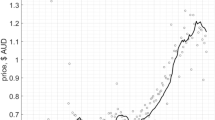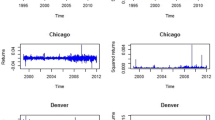Abstract
This paper investigates the association between real estate demand and the volatility of population changes. In a financial liberalized housing market, the housing mortgage loan implies insurance function to homeowners through the default option. Larger expected volatilities in the population imply a higher value of the default option. When analyzing the impact of the long-term population development on housing prices, the traditional deterministic population forecasting employed by previous research provides limited credibility. By means of the newly developed stochastic population forecasting methodology and counterfactual numerical simulations, we found a huge volatility associated with long-term population forecasting. A positive correlation between the expected volatility of population changes and real estate demand is ascertained.


Similar content being viewed by others
Notes
Hoynes and McFadden (1994)
The Supreme People’s Court of the People’s Republic of China.
Software R has been adopted to generate the multivariate normal distributed variables for changes in population, housing stock, and income. The singular value decomposition method was used in generating the multivariate normal distributed variables.
The data is from the 2009 Shanghai Statistics Yearbook. For the variables of income, population and housing supply, we use the published data on individual average disposable income, residential population and the area of newly constructed residential dwellings as the proxies.
For the minimum age of childbearing, β 4, we found that estimates were invariably equal to 15 years.
17.38, 17.32, and 16.76 million are for 2015, 2030, and 2040, respectively.
The price is published for January 2007 on http://www.ehomeday.com.
It is obtained by (predicted population mean in Year 2030 – population in Year 2000)/ population in Year 2000.
It is obtained by ((upper bound of 95% confidence interval – population in Year 2000)/ population in Year 2000)^2.
The “equivalent” population concept has been introduced by Mankiw and Weil (1989) and employed extensively afterwards. The core of “equivalent” population is to transform the nominal population number into another population number, which denotes an artificial population size as if all the people are at the same age group.
1.86, 5.03, and 10.08 million are for group younger than 25 years old, middle age group between 25 and 55 years old, and the old group with age above 55 years old, respectively.
\({\rm log}\left( {Y_t } \right)_{\rm adj} = {\rm log}\left( {Y_t } \right)-log\left( {Y_t } \right)_{\rm hat} ,\,\quad {\rm where} \quad {\rm log}\left( {Y_t } \right)_{\rm hat} =\hat {\gamma }_0 +\hat {\gamma }_1 {\rm log}\left( {N_t } \right)+\hat {\gamma }_2 {\rm log}\left( {K_t } \right).\)
\({\rm log}\left( {K_t } \right)_{\rm adj} = {\rm log}\left( {K_t } \right)-{\rm log}\left( {K_t } \right)_{\rm hat} ,\quad {\rm where} \quad {\rm log}\left( {K_t } \right)_{\rm hat} =\hat {\lambda }_0 +\hat {\lambda }_1 \,{\rm log}\left( {N_t } \right).\)
References
Abel AB (2001) Will bequests attenuate the predicted meltdown in stock prices when baby boomers retire? Rev Econ Stat 83(4):589–595
Abel AB (2003) The effects of a baby boom on stock prices and capital accumulation in the presence of social security. Econometrica 71(2):551–578
Ameriks J, Zeldes SP (2000) How do household portfolio shares vary with age? TIAA-CREF Working Paper
Bergantino S (1998) Life cycle investment behavior, demographics, and asset prices. Doctoral Dissertation, Department of Economics, MIT
Brooks RJ (1998) Asset market and saving effects of demographic transitions. Doctoral Dissertation, Department of Economics, Yale University
Cheng Y (2003) The impact of migration to shanghai on the performance of the social pension system. Master Thesis, Department of Economics, University of Oslo
China National Committee on Ageing (2008) The ageing of population and its implications in China. Country Statement. Available at http://en.cncaprc.gov.cn
Crawford GW, Rosenblatt E (1995) Efficient mortgage default option exercise: evidence from the mortgage insurance industry. J Real Estate Res 10(5):543–555
Cunningham D, Hendershott PH (1986) Pricing FHA mortgage default insurance NBER Working Paper No. W1382
Danthine JP, Donaldson JB (2002) Intermediate financial theory. Prentice Hall, Mahwah
Epperson JF, Kau JB, Kennan DC, Muller WJ (1985) Pricing default risk in mortgage. Rev Econ Stat 13(3):261–272
Fortin M, Leclerc A (2000) Demographic changes and real housing prices in Canada. Working Paper 00–06, Economics Department, University of Sherbrook
Foster C, Van Order R (1984) An option-based model of mortgage default. Hous Financ Rev 3(4):351–372
Foster C, Van Order R (1985) FHA terminations: a prelude to rational mortgage pricing. Rev Econ Stat 13(3):273–291
Girouard N, Kennedy M, Noord P, André C (2006) Recent house price developments: the role of fundamentals. OECD Economics Department Working Papers No. 475
Green MH (2003) Econometric analysis. Prentice Hall, NJ
Guiso L, Sapienza P, Zingales L (2009) Moral and social constraints to strategic default on mortgage. NBER Working Paper No. w15145
Han X (2010) Housing demand in Shanghai: a discrete choice approach. China Econ Rev 21(2):355–376
Hoem J, Hansen HO, Madsen D, Løvgreen Nielsen J, Olsen EM, Rennermalm B (1981) Experiments in modeling recent Danish fertility curves. Demography 18(2):231–244
Hoynes HW, McFadden D (1994) The impact of demographic on housing and non-housing wealth in the United States. NBER Working Paper No. w4666
Kau JB, Kim T (1994) Waiting to default: the value of delay. Rev Econ Stat 22(3):539–551
Kau JB, Keenan DC, Smurov AA (2004) Reduced-form mortgage valuation. Working Paper in Department of Insurance, Legal Studies and Real Estate, University of Georgia, Athens, Georgia
Keilman N, Pham D, Hetland A (2001) Norway’s uncertain demographic future. Working Paper in Statistics Norway, Oslo. ISBN 82–537–5002–1
Keilman N (2002) TFR predictions and Brownian motion theory. Yearb Popul Res Fin 38:209–221
Lutkepohl H (2005) New introduction to multiple time series analysis. Springer, Berlin
Mankiw NG, Weil DN (1989) The baby boom, the baby bust, and the housing market. Reg Sci Urban Econ 19(2):235–258
McFadden D (1993) Demographics, the housing market, and the welfare of the elderly. In: Wise D (ed) Studies in the economics of ageing. The University of Chicago Press, Chicago, pp 225–285
Ohtake F, Shintani M (1996) The effect of demographics on japanese housing market. Reg Sci Urban Econ 26(2):189–201
Ortalo-Magne F, Rady S (1999) Boom in, bust out: young household and the housing price cycle. Eur Econ Rev 43(4–6):755–766
Poterba JM (2001) Demographic structure and asset returns. Rev Econ Stat 83(4):565–584
Siegel J (1998) Stocks for the long run. McGraw Hill, New York
Vandell KD (1995) How ruthless is mortgage default? A review and synthesis of the evidence. J Hous Res 6(2):245–264
Yoo PS (1994) Age distributions and returns of financial assets. Federal Reserve Bank of St. Louis Working Paper 1994–002B
Acknowledgements
We would like to thank the anonymous referees, Nico Keilman, James M. Poterba, Olav Bjerkholt, John K. Dagsvik, Erik Biorn, Kaiji Chen, and Ke Wang for their valuable comments. We also gratefully acknowledge the support of National Natural Science Foundation of China (Research Project: #70632002, Fudan University, China) and the sponsor from Shanghai Pujiang Program.
Author information
Authors and Affiliations
Corresponding author
Additional information
Responsible editor: Alessandro Cigno
Appendix
Appendix
Starting from Eq. 14, we can get
Based on Eq. 29, we can have
The variance of \(\mathop P\limits^\bullet \) can be expressed as
To get the testable empirical counterpart of the Eq. 29, we first transform the variable into logarithm.
Then, we have the empirical regression specification as
If we regress Eq. 32 directly, it is going to be serious multicollinearities between the variables as testified by the correlations in Table 9. Therefore, we use the adjusted income and housing supplyFootnote 13 as the regressor instead. The regression results are presented in Table 10.
New residential land area allocated in Shanghai from 1995 to 2008. Source: 2002 and 2009 Shanghai statistics yearbook. For years before 2000, the new residential land volumes are published by the Statistics Yearbook 2000. For years after 2000, the new residential land areas are not published directly. Rather, the traded land volumes are published, which include both the new and the re-traded land. To proxy the new land volume, we subtract the residential volume of the “movers” from the total number
Rights and permissions
About this article
Cite this article
Cheng, Y., Han, X. Does large volatility help?—stochastic population forecasting technology in explaining real estate price process. J Popul Econ 26, 323–356 (2013). https://doi.org/10.1007/s00148-010-0349-1
Received:
Accepted:
Published:
Issue Date:
DOI: https://doi.org/10.1007/s00148-010-0349-1














